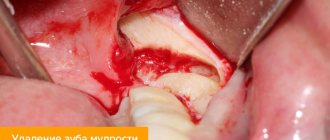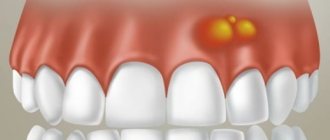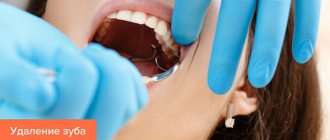Methods for removing wisdom teeth
Wisdom teeth, which dentists call figure eights, complete the dentition. It is difficult to reach them with a toothbrush, which is why their enamel is especially susceptible to caries. In addition, they begin to erupt when the rest of the teeth have already grown. Eights sometimes rest against neighboring teeth, contributing to their destruction.
The difficulty of removing wisdom teeth largely depends on the location of the roots and the presence of concomitant diseases (pulpitis, periodontitis):
- if the roots are not intertwined, the tooth grows smoothly and there are no associated diseases, it is removed relatively simply, using forceps or an elevator;
- if the roots are tangled, the tooth is curved or its crown part is destroyed, the tissues around it are inflamed, dentists have to use more traumatic methods: cutting the gum and then applying sutures. In particularly difficult cases, the wisdom tooth is removed under general anesthesia.
What to do if the problem persists
Outside intervention in the body causes certain reactions, especially if the process was complex. Therefore, complex tooth extraction causes various side effects: swelling of the cheek, bleeding gums, fever. Patients complain of pain in the throat, ear, difficulty chewing and moving the jaws. Anomalies appear from damage to soft tissues. After all, the blood circulating there becomes free. It fills cavities, which leads to swelling. This is what prevents the patient from fully opening his mouth.
After conduction anesthesia, pathologies appear. Therefore, after wisdom tooth removal, it is painful to open your mouth and swallow. If the discomfort gradually subsides, this is normal and there is no need to worry. However, when the pain increases, becomes stronger every day, and does not go away for a long time, the patient must definitely visit a doctor. The sooner this is done, the faster and easier the therapy will be.
Re-cleaning the hole
If it hurts to open your mouth, a specialist should determine the cause of the abnormality. For this purpose, diagnosis is carried out and treatment is prescribed. Often, dentists in such situations clean the wound again. With curved roots, cysts can form and caries can develop, moving into an advanced phase. There are situations when the entire root cannot be removed at once. For the patient to recover, the surgeon must perform another cleaning. Also, this procedure is resorted to when a fragment is accidentally left behind. Pain and discomfort will go away when the wound is clean.
Physiotherapy
When the mouth is difficult to open and the jaw hurts, the following may be prescribed:
- Electrophoresis;
- Ultraviolet irradiation;
- UHF;
- Fluctuarization;
- Laser therapy;
- Magnetotherapy;
- Darsonvalization;
In addition to basic treatment, physiotherapeutic procedures accelerate healing. Complex therapy helps reduce the process of intense inflammation, eliminate discomfort, and fight pathogens.
Antibiotics
A common problem with Eights is dystopia. Since this provokes serious problems, a dystopic wisdom tooth in many cases must be removed. After all, such rudiments are located incorrectly. Their position is not vertical, but horizontal or inclined. Indications for extraction:
- Development of caries, pulpitis, periodontitis, when therapy does not bring a positive result;
- Serious damage to the unit located opposite;
- Impacted organ with inflamed mucous tissue;
- Orthodontic therapy of crowded anterior units;
Drug treatment for complications depends on the characteristics of the patient’s disease. If inflammation develops in the oral cavity, antibiotics are prescribed to eliminate the source of infection. This may be Lincomycin, Ciprolet, Dalacin, Amoxicillin or Ciprofloxacin. Antibacterial agents such as streptocide or sulfacyl can be used.
Jaw development with exercises
For patients with pain, doctors recommend rinsing with chlorhexidine, furatsilin, miramistin 24 hours after surgery. If the mouth does not open completely, the jaws should be developed. If you have difficulty moving, you need to help open the jaw with your fingers. It is important that the patient does not overdo it. Development is performed when the patient experiences mild pain. Gymnastics involves smooth opening of the mouth and soft chewing movements. The load increases gradually.
Full restoration of function will be noticeable after 15-20 days. Massage and heat therapy will help you recover faster. Moving a toothbrush with soft bristles improves blood circulation. Healing is accelerated by mud, paraffin, and ozokerite applications. In the first days, you need to exclude solid foods from your diet. It is useful to eat jelly, grated soups, and liquid porridges. On days 8-12, you can include regular dishes in the menu.
Symptoms after wisdom tooth removal
Once the anesthesia wears off, the patient begins to experience pain.
Possible symptoms:
- jaw pain (during the normal course of the healing process is aching) - occurs due to the fact that during the procedure the dentist violates the integrity of the tissues, blood vessels, and nerve endings of neighboring teeth. The wound left after removing the figure eight is filled with a blood clot. Sometimes the jaw ache simply because the patient keeps his mouth open for a long time. In addition, the doctor has to make additional efforts, the ligaments become strained;
- pain when opening the mouth or swallowing, increased salivation occurs if the dentist disturbed the trigeminal nerve during dental treatment;
- swelling of the gums or cheeks - most often appears after the removal of lower teeth;
- temperature rise to 37.5 °C;
- a hematoma on the cheek is a consequence of damage to the capillaries.
Depending on the individual characteristics of the body, healing lasts from 3 to 7 days. The aching pain after taking analgesics prescribed by the doctor does not interfere with the patient’s sleep, gradually subsides, and ceases to be felt 7–10 days after tooth extraction. A blood clot forms at the site of the extracted tooth; on the 3rd–4th day, the hole begins to fill with granulation tissue, and after 3 months - with bone.
There are fewer nerve endings associated with the upper teeth, and the root system is less branched, so it is easier to remove such teeth and the pain goes away faster. If the doctor made an incision when removing the figure eight, the pain lasts longer.
Causes of pain after removal
The severity of pain depends on the complexity of the operation performed. Normally, pain may occur immediately after the anesthetic wears off, and discomfort may persist for 2-3 days. Then the symptom should subside. Sometimes dentists allow pain to persist for five days, but in the absence of other complaints.
The main cause of pain in the socket area after wisdom tooth removal is alveolitis. Inflammation of the socket develops for the following reasons:
- Highly traumatic surgical procedure.
- Incomplete sanitation of the hole, preservation of tooth fragments in it.
- Injuries to the mucous membrane during surgery, for example, with a bur when dividing roots or with forceps when applying cheeks to the walls of a tooth.
- Refusal to apply sutures if there are direct indications for the procedure.
- No course of antibiotics after complex tooth extraction.
Characteristic will be an increase in pain and the addition of other signs of inflammation. The only right decision in this situation is to visit the dentist.
When to see a doctor
Wound healing after removal of the figure eight is always a painful process, but sometimes it is accompanied by complications. To avoid causing a serious deterioration in your health, you should consult a doctor if the following symptoms appear:
- the pain intensifies every day, analgesics help little;
- the pain does not go away a week after tooth extraction;
- the pain is not aching, but pulsating, it radiates to the neck, eye, temple, and interferes with sleep. Such sensations are a sign of an inflammatory process; you should consult a doctor immediately;
- swelling does not disappear completely on the 2nd–3rd day after surgery, but, on the contrary, increases;
- temperature rises above 37.5 °C;
- the temperature does not drop to normal on the 2nd–3rd day after surgery;
- an allergic reaction to a hemostatic sponge or analgesics occurs;
- alveolitis (inflammatory disease) occurs in the socket. This happens if a part of the root remains in the hole, a blood clot did not form or was washed out during hygiene procedures, the patient violated the rules of oral care, which is why an infection got into the wound;
- your health worsens on the 2nd–3rd day after the procedure.
Difficulty erupting
The eruption of the eighth tooth is difficult for a number of reasons. Firstly, there has never been a baby tooth in its place, and the gums are not prepared. Secondly, this tooth begins to grow in adulthood. By the time the jaw bones erupt, they are already formed. Therefore, the wisdom tooth has difficulty making its way through. And this entails inflammation of the tissues surrounding the tooth. It is manifested by an increase in body temperature and pain, which sometimes makes it even difficult to open your mouth. Also, when teething is difficult, patients often complain of pain in the throat or ear.
How long does a wisdom tooth grow? The teething process can be quite lengthy. Therefore, the symptoms of inflammation, if present, will bother you for a long time. And this is fraught with serious consequences, including bone inflammation. In rare cases, inflammation accompanies a wisdom tooth cyst. Therefore, if you experience prolonged pain, you should consult a dentist.
Rules for oral care after wisdom tooth removal
In order for healing to proceed normally, without any additional problems, it is recommended to adhere to the following rules:
- remove the tampon 20 minutes after surgery;
- for 3 hours after removing the figure eight, do not eat or drink;
- Do not rinse your mouth on the day of surgery;
- In the first few days after surgery, avoid hard foods and eat warm, soft foods. Chew food on the other side of the jaw, protecting the wound from foreign particles getting into it. Do not drink anything hot;
- in the first 7–10 days, avoid alcohol (it slows down healing and cannot be combined with analgesics);
- in the first week, do not visit training rooms and swimming pools, do not work in the garden, do not do cleaning, avoid physical activity, especially those associated with bending;
- in the first week do not visit baths, saunas, solariums, or sunbathe in the open air;
- do not heat the socket area (do not use warming compresses), do not use a UHF device;
- Do not brush your teeth for the first 24 hours after surgery, then for 10 days when brushing your teeth, try not to catch the socket with the brush;
- on the 2-3rd day after the operation, make passive baths with chlorhexidine or another antiseptic (spiking the solution into your mouth and tilting your head towards the hole, just hold for a while, then spit), starting from the 4th day - use chamomile or sage decoctions ;
- take only those analgesics prescribed by the doctor, apply cold compresses.
If the pain intensifies or other alarming symptoms appear, you should never touch the socket with your fingers to check its condition. You need to see a doctor: if there really is a problem, he can prescribe an x-ray, and then select a treatment regimen.
Increased risk of caries
Due to lack of space on the jaw, wisdom teeth may be in an incorrect position. If there is a tilt towards the adjacent tooth, food accumulates in the space between them. In this case, cleaning is usually difficult, so sooner or later caries of the neighboring tooth occurs. In addition, cleaning a wisdom tooth while it is growing, and it can take quite a long time to grow, is also problematic. Therefore, bacteria accumulate on it for a long time, which inevitably leads to the early development of caries.
How to relieve pain at home
The most effective way to prevent wisdom tooth pain is to visit a dentist. When this is temporarily impossible, you should try to relieve pain and inflammation on your own. You can temporarily get rid of unpleasant symptoms with the help of analgesics, anti-inflammatory drugs, local anesthetics, and rinses.
Taking medications
Painkillers help cope with pain. Unfortunately, the effect of their use does not last long, up to 8 hours. The most popular tablets:
- Analgin.
- Dexalgin.
- Tempalgin.
Analgesic compounds cannot be used continuously because they cause serious adverse reactions (for example, disruption of the hematopoietic process, problems with the organs of the excretory system). In this case, the medications act urgently in one dose when the gums near the removed wisdom tooth hurt.
Ibuprofen, Nimesulide, Ibufen, Ketorol and other anti-inflammatory drugs act comprehensively, reducing pain, relieving swelling and lowering body temperature. You should not take them more than 3 times a day and on an empty stomach. Possible adverse reactions from the gastrointestinal tract, worsening blood clotting.
External gels (Kalgel, Kamistad) are very popular, which not only relieve pain, but also eliminate inflammation and disinfect. Some formulations are allowed to be used when teething milk units in infants. Solcoseryl and Cholisal have antibacterial properties and promote faster wound healing.
Rinse for pain
How to rinse and numb when a wisdom tooth hurts? Positive dynamics are observed after the procedure performed using such means as:
- Infusions, decoctions of herbs and other plants. Most often, patients choose chamomile, sage, and oak bark. By rinsing your mouth, you can quickly clean gum pockets and prevent possible infection.
- A solution of soda and salt. They help wash away purulent contents and get rid of swelling.
- Hydrogen peroxide, potassium permanganate and water. This is a homemade antiseptic composition that disinfects gums. It is necessary to carry out such manipulations as often as possible (at least 8 times a day).
How to relieve pain when wisdom teeth erupt?
Patients often turn to the dentist with complaints of pain when their wisdom teeth erupt. If the tooth is positioned correctly, the hood over the wisdom tooth is often removed to facilitate eruption. In this case, the gum is excised, making way for the growing tooth. Folk remedies are also used when wisdom teeth erupt. For example, to relieve inflammation of the gums, it is recommended to rinse your mouth with antiseptic solutions. A solution of water with soda and salt is especially effective. It disinfects injured gums well. In addition, you can relieve pain with analgesics. But sometimes folk remedies are not enough to treat a wisdom tooth. If serious complications occur, preference is given to removing the eighth teeth.
Having familiarized yourself with all the possible problems that a wisdom tooth can cause, you should not perceive it as one big nuisance. The main thing is, if any symptoms occur, do not hesitate to visit a doctor. He will certainly help relieve discomfort and choose the right solution. In the “Search” section of our website you will definitely find a dental clinic in Moscow that will suit you in terms of price and location.
What to do if a wisdom tooth grows and your jaw hurts during pregnancy
The female body is especially vulnerable during pregnancy, regardless of the period. This is due to decreased immunity, early toxicosis or gestosis, changes in hormonal levels and other reasons.
Unfortunately, expectant mothers cannot be treated according to standard regimens developed by doctors. Antibacterial drugs and painkillers containing analgesics are contraindicated for them.
In the absence of complications, it is better to opt for gels for topical use, suitable for infants. If there is an increase in body temperature, it is allowed to take paracetamol and medications based on it. The dosage should be calculated exclusively by a doctor, otherwise it can harm the fetus.
In advanced situations, it is necessary to operate on the patient and remove the pathological dental unit. Such manipulations are recommended to be carried out in the second trimester.











